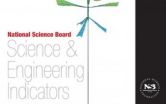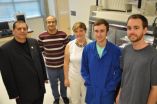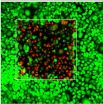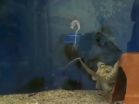(Press-News.org) PITTSBURGH—Clouds play a critical role in Earth's climate. Clouds also are the largest source of uncertainty in present climate models, according to the latest report of the Intergovernmental Panel on Climate Change. Much of the uncertainty surrounding clouds' effect on climate stems from the complexity of cloud formation.
New research from scientists at the CLOUD (Cosmics Leaving OUtdoor Droplets) experiment at CERN, including Carnegie Mellon University's Neil Donahue, sheds light on new-particle formation — the very first step of cloud formation and a critical component of climate models. The findings, published in the May 16 issue of Science, closely match observations in the atmosphere and can help make climate prediction models more accurate.
Cloud droplets form when water vapor in the atmosphere condenses onto tiny particles. These particles are emitted directly from natural sources or human activity, or they form from precursors emitted originally as gaseous pollutants. The transformation of gas molecules into clusters and then into particles, a process called nucleation, produces more than half of the particles that seed cloud formation around the world today. But the mechanisms underlying nucleation remain unclear. Although scientists have observed that the nucleation process nearly always involves sulfuric acid, sulfuric acid concentrations aren't high enough to explain the rate of new particle formation that occurs in the atmosphere. This new study uncovers an indispensable ingredient to the long sought-after cloud formation recipe — highly oxidized organic compounds.
"Our measurements connect oxidized organics directly, and in detail, with the very first steps of new particle formation and growth," said Donahue, professor of chemistry, chemical engineering, engineering and public policy, and director of CMU's Steinbrenner Institute for Environmental Education and Research.
"We had no idea a year ago that this chemistry was happening. There's a whole branch of oxidation chemistry that we didn't really understand. It's an exciting time."
The air we breathe is chock-full of organic compounds, tiny liquid or solid particles that come from hundreds of sources including trees, volcanoes, cars, trucks and wood fires. Once they enter the atmosphere, these so-called organics start to change. In research published in the Proceedings of the National Academy of Sciences in 2012, Donahue and colleagues showed conclusively that organic molecules given off by pine trees, called alpha-pinene, are chemically transformed multiple times in the highly oxidizing environment of the atmosphere.
Additionally, other research, including from Donahue's lab, has suggested that such oxidized organics might take part in nucleation — both in new particle formation and in their subsequent growth. Donahue and an international team of researchers with the CLOUD experiment at CERN set out to test that hypothesis.
The CLOUD project at CERN is a unique facility that allows scientists to reproduce a typical atmospheric setting inside of an essentially contaminant-free, stainless steel chamber. By performing experiments in the precisely controlled environment of the CLOUD chamber, the project's scientists can change the concentrations of chemicals involved in nucleation and then measure the rate at which new particles are created with extreme precision.
In the current work, the team filled the chamber with sulfur dioxide and pinnanediol (an oxidation product of alpha-pinene) and then generated hydroxyl radicals (the dominant oxidant in Earth's atmosphere). Then they watched the oxidation chemistry unfold. Using very high-resolution mass spectrometry, the scientists were able to observe particles growing from single, gaseous molecules to clusters of up to 10 molecules stuck together, as they grew molecule by molecule.
"It turns out that sulfuric acid and these oxidized organic compounds are unusually attracted to each other. This remarkably strong association may be a big part of why organics are really drawn to sulfuric acid under modern polluted conditions," Donahue said.
After confirming that oxidized organics are involved in the formation and growth of particles under atmospheric conditions, the scientists incorporated their findings into a global particle formation model. The fine-tuned model not only predicted nucleation rates more accurately but also predicted the increases and decreases of nucleation observed in field experiments over the course of a year, especially for measurements near forests. This latter test is a strong confirmation of the fundamental role of emissions from forests in the very first stage of cloud formation, and that the new work may have succeeded in modeling that influence.
INFORMATION:
Researchers show emissions from forests influence very first stage of cloud formation
Research from CLOUD experiment at CERN, which includes Carnegie Mellon's Neil Donahue, contributes to better understanding of connection between clouds and climate
2014-05-15
ELSE PRESS RELEASES FROM THIS DATE:
New data show how states are doing in science
2014-05-15
The newly updated, online, interactive state data tool allows policymakers, educators and other users to discern trends in education, science and research in each of the 50 states. This free resource supplements the state data in the 2014 Science and Engineering Indicators report, the premier source of information and analysis of the nation's position in science and engineering education and research. The biennial report is published by the National Science Board, the policy making body of the National Science Foundation (NSF).
The tool features 59 state indicators of ...
UH Case Medical Center neurosurgeon uses depth electrodes for speech mapping
2014-05-15
CLEVELAND -- At the 2014 American Association of Neurological Surgeons Annual Meeting, neurosurgical researchers from University Hospitals (UH) Case Medical Center presented results from a small study looking at deep brain electrode implantation as a possible alternative to the traditional WADA test used prior to epilepsy surgery.
The WADA test is considered the gold standard for identifying the side of the brain for speech dominance. In the WADA test, doctors put one half of a patient's brain to sleep for a few minutes using medication and then have the patient read ...
Study: Targeted funding can help address inequities in early child care programs
2014-05-15
CORVALLIS, Ore. – The quality of early child care and education programs is influenced both by funding and by the characteristics of the communities in which the programs operate, new research from Oregon State University shows.
The findings indicate that law- and policy-makers may need to consider the demographics of communities when making funding decisions about early childhood programs, said Bridget Hatfield, an assistant professor in OSU's College of Public Health and Human Sciences.
That's especially important now because many states, including Oregon, are adopting ...
Fires in San Diego County blazing
2014-05-15
The single fire that ignited and split into nine separate fires still blazes in Southern California today. Firefighters are hoping for a break today (Thursday, May 15, 2014) but it doesn't look like luck may be on their side. Conditions continue to be bone dry with unseasonal heat (98-106 degrees) and the Santa Ana winds are kicking up and allowing these fires to easy jump fire lines. This particular fire started on Wednesday as a single fire and within a day is now nine separate fires which have burned close to 10,000 acres. These fires are threatening more than just ...
Giant telescope tackles orbit and size of exoplanet
2014-05-15
Using one of the world's largest telescopes, a Lawrence Livermore team and international collaborators have tracked the orbit of a planet at least four times the size of Jupiter.
The scientists were able to identify the orbit of the exoplanet, Beta Pictoris b, which sits 63 light years from our solar system, by using the Gemini Planet Imager's (GPI) next-generation, high-contrast adaptive optics (AO) system. This approach is sometimes referred to as extreme AO.
The Gemini Planet Imager snapped an amazingly clear and bright image of the gas giant Beta Pictoris b after ...
Detailed studies reveal how key cancer-fighting protein is held in check
2014-05-15
St. Jude Children's Research Hospital scientists have mapped the structural details of how p53 attaches to its regulatory protein, called BCL-xL, in the cell. The protein p53 is a key activator of the cell's protective machinery against genetic damage, such as the mutations that drive cancer cells' explosive growth.
The detailed understanding of how these two molecular puzzle pieces fit together will help scientists design drugs that release p53 in cancer cells, triggering their suicide, called apoptosis.
The findings appear in the current online journal Nature Structural ...
Researchers examine intersection of aging, chronic disease
2014-05-15
A new collection of articles appearing in The Journals of Gerontology, Series A: Biological Sciences and Medical Sciences examine how the basic biology of aging drives chronic disease. Together, they highlight the value of the emerging field of geroscience, which uses an integrated approach to the study of diseases and disability associated with growing older.
Geroscience seeks to bridge the divide between studies of aging and studies of chronic disease, with the hope of understanding their complex relationship and pointing the way to novel interventions for disease, ...
Silly Putty material inspires better batteries
2014-05-15
RIVERSIDE, Calif. (http://www.ucr.edu) — Using a material found in Silly Putty and surgical tubing, a group of researchers at the University of California, Riverside Bourns College of Engineering have developed a new way to make lithium-ion batteries that will last three times longer between charges compared to the current industry standard.
The team created silicon dioxide (SiO2) nanotube anodes for lithium-ion batteries and found they had over three times as much energy storage capacity as the carbon-based anodes currently being used. This has significant implications ...
Going beyond the surface
2014-05-15
BUFFALO, N.Y. – Photodynamic therapy (PDT) is an effective treatment for easily accessible tumors such as oral and skin cancer.
But the procedure, which uses lasers to activate special drugs called photosensitizing agents, isn't adept at fighting cancer deep inside the body. Thankfully, that's changing due to new technology that could bring PDT into areas of the body which were previously inaccessible.
Described May 11 in the journal Nature Photonics, the approach involves using near-infrared beams of light that, upon penetrating deep into the body, are converted into ...
How octopuses don't tie themselves in knots
2014-05-15
VIDEO:
An octopus is treating its own freshly amputated arm in a strange and exploratory manner that is not commonly seen with respect to food items. Note the 'startle' response of...
Click here for more information.
An octopus's arms are covered in hundreds of suckers that will stick to just about anything, with one important exception. Those suckers generally won't grab onto the octopus itself; otherwise, the impressively flexible animals would quickly find themselves all tangled ...
LAST 30 PRESS RELEASES:
Heart-brain connection: international study reveals the role of the vagus nerve in keeping the heart young
Researchers identify Rb1 as a predictive biomarker for a new therapeutic strategy in some breast cancers
Survey reveals ethical gaps slowing AI adoption in pediatric surgery
Stimulant ADHD medications work differently than thought
AI overestimates how smart people are, according to HSE economists
HSE researchers create genome-wide map of quadruplexes
Scientists boost cell "powerhouses" to burn more calories
Automatic label checking: The missing step in making reliable medical AI
Low daily alcohol intake linked to 50% heightened mouth cancer risk in India
American Meteorological Society announces Rick Spinrad as 2026 President-Elect
Biomass-based carbon capture spotlighted in newly released global climate webinar recording
Illuminating invisible nano pollutants: advanced bioimaging tracks the full journey of emerging nanoscale contaminants in living systems
How does age affect recovery from spinal cord injury?
Novel AI tool offers prognosis for patients with head and neck cancer
Fathers’ microplastic exposure tied to their children’s metabolic problems
Research validates laboratory model for studying high-grade serous ovarian cancer
SIR 2026 delivers transformative breakthroughs in minimally invasive medicine to improve patient care
Stem Cell Reports most downloaded papers of 2025 highlight the breadth and impact of stem cell research
Oxford-led study estimates NHS spends around 3% of its primary and secondary care budget on the health impacts of heat and cold in England
A researcher’s long quest leads to a smart composite breakthrough
Urban wild bees act as “microbial sensors” of city health.
New study finds where you live affects recovery after a hip fracture
Forecasting the impact of fully automated vehicle adoption on US road traffic injuries
Alcohol-related hospitalizations from 2016 to 2022
Semaglutide and hospitalizations in patients with obesity and established cardiovascular disease
Researchers ‘listen in’ to embryo-mother interactions during implantation using a culture system replicating the womb lining
How changing your diet could help save the world
How to make AI truly scalable and reliable for real-time traffic assignment?
Beyond fragmented markets: A new framework for efficient and stable ride-pooling
Can shape priors make road perception more reliable for autonomous driving?
[Press-News.org] Researchers show emissions from forests influence very first stage of cloud formationResearch from CLOUD experiment at CERN, which includes Carnegie Mellon's Neil Donahue, contributes to better understanding of connection between clouds and climate





